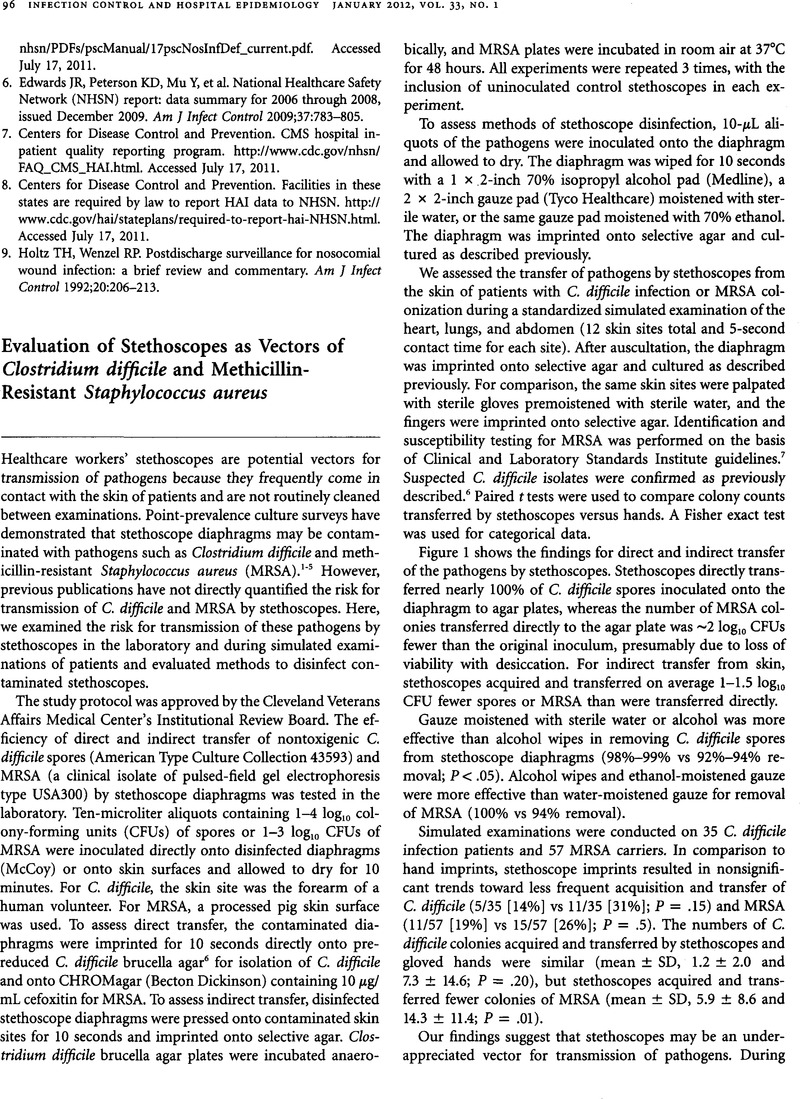Crossref Citations
This article has been cited by the following publications. This list is generated based on data provided by Crossref.
Muniz, Jeanette
Sethi, Rosh K.V.
Zaghi, Justin
Ziniel, Sonja I.
and
Sandora, Thomas J.
2012.
Predictors of stethoscope disinfection among pediatric health care providers.
American Journal of Infection Control,
Vol. 40,
Issue. 10,
p.
922.
Cecil, Jane A.
2012.
Clostridium difficile: Changing Epidemiology, Treatment and Infection Prevention Measures.
Current Infectious Disease Reports,
Vol. 14,
Issue. 6,
p.
612.
Munoz-Price, L. Silvia
and
Birnbach, David J.
2013.
Hand Hygiene and Anesthesiology.
International Anesthesiology Clinics,
Vol. 51,
Issue. 1,
p.
79.
Alspach, JoAnn Grif
2014.
About That Health Care Icon Dangling Around Your Neck: Do We Have Some Cleaning Up to Do?.
Critical Care Nurse,
Vol. 34,
Issue. 3,
p.
11.
Maki, Dennis G.
2014.
Stethoscopes and Health Care–Associated Infection.
Mayo Clinic Proceedings,
Vol. 89,
Issue. 3,
p.
277.
Calfee, David P.
Salgado, Cassandra D.
Milstone, Aaron M.
Harris, Anthony D.
Kuhar, David T.
Moody, Julia
Aureden, Kathy
Huang, Susan S.
Maragakis, Lisa L.
and
Yokoe, Deborah S.
2014.
Strategies to Prevent Methicillin-ResistantStaphylococcus aureusTransmission and Infection in Acute Care Hospitals: 2014 Update.
Infection Control & Hospital Epidemiology,
Vol. 35,
Issue. 7,
p.
772.
Calfee, David P.
Salgado, Cassandra D.
Milstone, Aaron M.
Harris, Anthony D.
Kuhar, David T.
Moody, Julia
Aureden, Kathy
Huang, Susan S.
Maragakis, Lisa L.
and
Yokoe, Deborah S.
2014.
Strategies to Prevent Methicillin-ResistantStaphylococcus aureusTransmission and Infection in Acute Care Hospitals: 2014 Update.
Infection Control & Hospital Epidemiology,
Vol. 35,
Issue. S2,
p.
S108.
Saiman, Lisa
Siegel, Jane D.
LiPuma, John J.
Brown, Rebekah F.
Bryson, Elizabeth A.
Chambers, Mary Jo
Downer, Veronica S.
Fliege, Jill
Hazle, Leslie A.
Jain, Manu
Marshall, Bruce C.
O’Malley, Catherine
Pattee, Suzanne R.
Potter-Bynoe, Gail
Reid, Siobhan
Robinson, Karen A.
Sabadosa, Kathryn A.
Schmidt, H. Joel
Tullis, Elizabeth
Webber, Jennifer
and
Weber, David J.
2014.
Infection Prevention and Control Guideline for Cystic Fibrosis: 2013 Update.
Infection Control & Hospital Epidemiology,
Vol. 35,
Issue. S1,
p.
s1.
Honda, Hitoshi
and
Dubberke, Erik R.
2014.
Clostridium difficile infection in solid organ transplant recipients.
Current Opinion in Infectious Diseases,
Vol. 27,
Issue. 4,
p.
336.
O'Flaherty, N.
and
Fenelon, L.
2015.
The stethoscope and healthcare-associated infection: a snake in the grass or innocent bystander?.
Journal of Hospital Infection,
Vol. 91,
Issue. 1,
p.
1.
Nagaraja, Aarathi
Visintainer, Paul
Haas, Janet P.
Menz, Jonathan
Wormser, Gary P.
and
Montecalvo, Marisa A.
2015.
Clostridium difficile infections before and during use of ultraviolet disinfection.
American Journal of Infection Control,
Vol. 43,
Issue. 9,
p.
940.
Loo, Vivian G.
2015.
Environmental Interventions to Control Clostridium difficile.
Infectious Disease Clinics of North America,
Vol. 29,
Issue. 1,
p.
83.
Ali, S.
Goryaeva, M.
Kotronias, R.A.
Cereceda-Monteoliva, N.
Ward, N.
Corkill, J.
Sheriff, I.H.N.
Amadi, C.
and
Fountain, D.M.
2016.
Have you cleaned your stethoscope today?.
Journal of Hospital Infection,
Vol. 94,
Issue. 3,
p.
281.
Tschopp, Clément
Schneider, Alexis
Longtin, Yves
Renzi, Gesuele
Schrenzel, Jacques
and
Pittet, Didier
2016.
Predictors of Heavy Stethoscope Contamination Following a Physical Examination.
Infection Control & Hospital Epidemiology,
Vol. 37,
Issue. 6,
p.
673.
Cooper, Christopher C.
Jump, Robin L.P.
and
Chopra, Teena
2016.
Prevention of Infection Due to Clostridium difficile.
Infectious Disease Clinics of North America,
Vol. 30,
Issue. 4,
p.
999.
McFarland, Lynne V.
2017.
Primary prevention of Clostridium difficile infections – how difficult can it be?.
Expert Review of Gastroenterology & Hepatology,
Vol. 11,
Issue. 6,
p.
507.
Camacho-Ortiz, Adrián
and
Chavez-Moreno, Susana
2017.
Pearls in Infection Control for Clostridium difficile Infections in Healthcare Facilities.
Current Treatment Options in Infectious Diseases,
Vol. 9,
Issue. 2,
p.
117.
Noor, Asif
and
Krilov, Leonard R.
2018.
Clostridium difficile
Infection in Children
.
Pediatric Annals,
Vol. 47,
Issue. 9,
McDonald, L Clifford
Gerding, Dale N
Johnson, Stuart
Bakken, Johan S
Carroll, Karen C
Coffin, Susan E
Dubberke, Erik R
Garey, Kevin W
Gould, Carolyn V
Kelly, Ciaran
Loo, Vivian
Shaklee Sammons, Julia
Sandora, Thomas J
and
Wilcox, Mark H
2018.
Clinical Practice Guidelines for Clostridium difficile Infection in Adults and Children: 2017 Update by the Infectious Diseases Society of America (IDSA) and Society for Healthcare Epidemiology of America (SHEA).
Clinical Infectious Diseases,
Vol. 66,
Issue. 7,
p.
e1.
Kozlov, Roman S.
Shelygin, Yu.A.
Veselov, Alexander V.
Dekhnich, Andrey V.
Zubareva, N.A.
Ershova, O.N.
Kulabukhov, V.V.
Popov, Dmitriy A.
Reshedko, G.K.
and
Yakushin, Sergey B.
2018.
Review of updated clinical practice guidelines of the Infectious Diseases Society of America (IDSA) and Society for Healthcare Epidemiology of America (SHEA) for Clostridium difficile infection in adults and children (2017).
Clinical Microbiology and Antimicrobial Chemotherapy,
Vol. 20,
Issue. 2,
p.
76.





